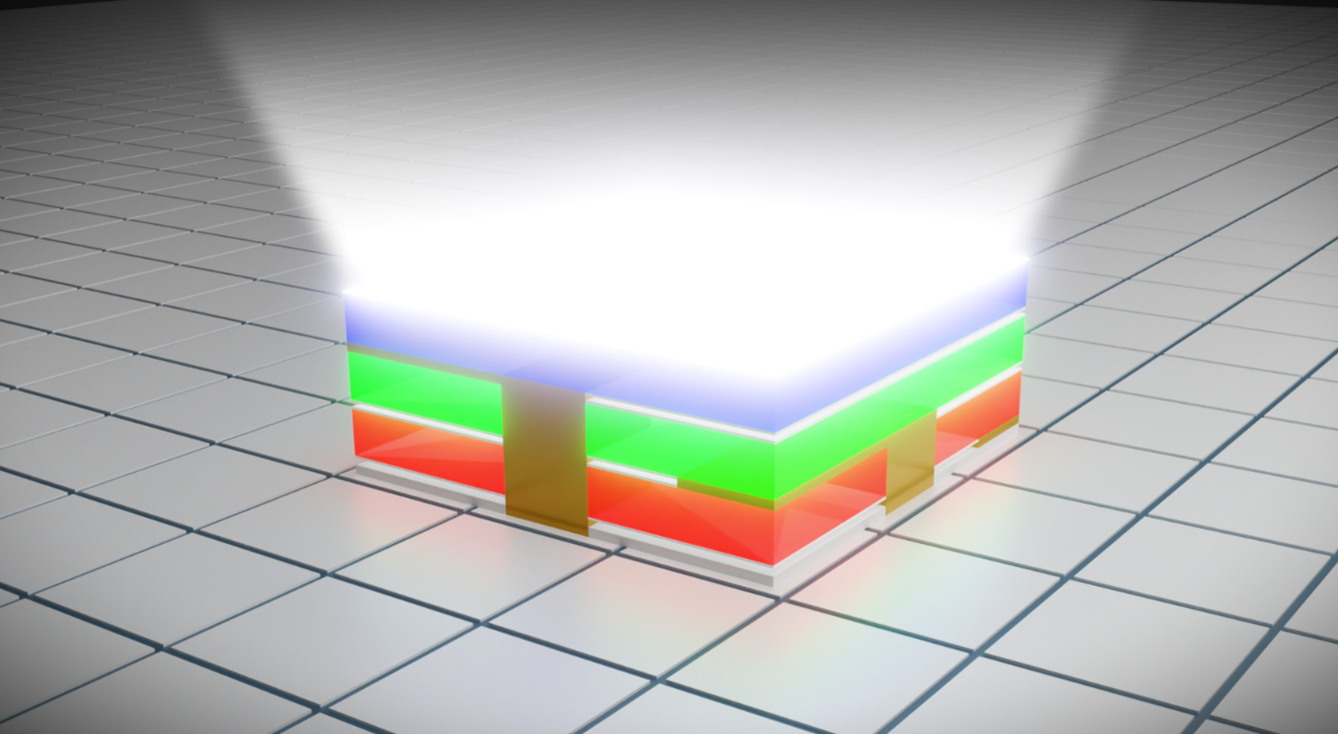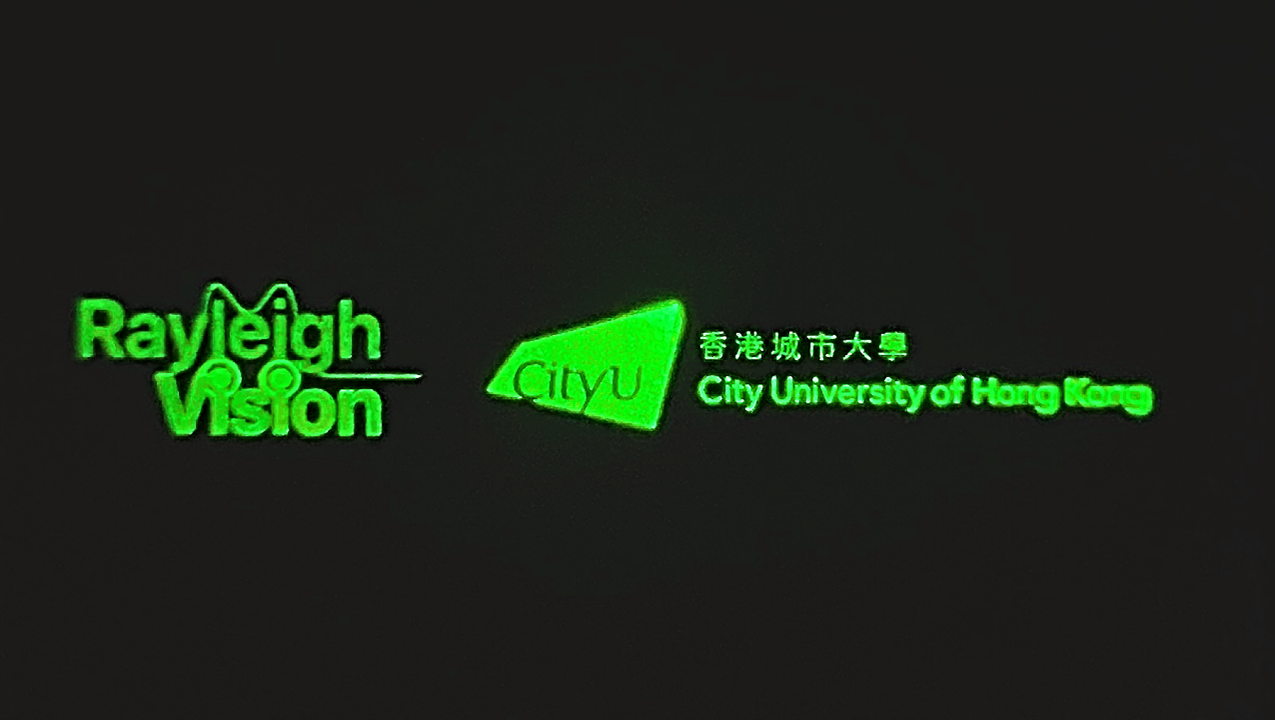HONG KONG- Following Apple's recent launch of mixed reality (MR) glasses, the importance of microdisplay technology has come to the forefront. Microdisplays are a critical and costly component of visual systems for virtual, augmented, and mixed reality applications.
"Apple's venture into mixed reality, albeit remarkable, is tethered to MicroOLED displays. These come with their baggage—like soaring costs, compromised brightness, and longevity concerns," shared Dr. Eddy Hsu, the co-founder of the influential Rayleigh Vision with over 20-year experience in Micro-LED displays.
The microdisplay research team, led by Professor Jr-Hau HE at City University of Hong Kong and its spin-off company Rayleigh Vision, has made significant advancements in Micro-LED technology to overcome the current limitations. Their newly announced two-layer microdisplay array showing a disruptive stacking technology, to craft dual-layer units where each layer can modulate colors independently. The team's stacking approach has gained initial validation and is on track to cultivate an RGB full-color Micro-LED. This advancement is expected to quadruple pixel density by the end of 2023. This product boasts high contrast, high brightness, wide color gamut, high efficiency, low power consumption, and long lifetime, making it suitable for a wide range of applications in entertainment, consumer electronics, and professional industries.

Illustrative graphic of Rayleigh Vision’s developing 3-layer stacked Micro-LED chip.
With hubs in California, Hong Kong, and Taiwan, it's Rayleigh Vision's approach to Micro-LEDs that has industry insiders talking. The team has launched several innovative products, such as the 0.55” full-color Micro-LED microdisplay and an impressive 0.38” Micro-LED microdisplay boasting a pixel density of 3780 ppi. Moreover, by achieving a technological feat in successfully cultivating 2.5 μm Micro-LED pixels and building a pixel array with a staggering density exceeding 10,000 ppi, Rayleigh Vision become one of the select teams in the market capable of harnessing this cutting-edge technology.

The research team’s 0.55” Micro-LED display in 2020, showcasing its logos.
Dr. He emphasized, 'While stacked Micro-LED technology holds immense potential, it also faces several challenges, including precise alignment, repair difficulties, heat dissipation, as well as innovations in the stacked structure and materials used for connecting LEDs. However, Rayleigh Vision has made significant breakthroughs in these areas.
At Rayleigh Vision, our stacked Micro-LED products not only offer higher pixel density but also incorporate our patented innovations to achieve higher energy efficiency and superior display quality in terms of brightness, contrast, and color representation. Moreover, our patents also address crucial challenges in the mass production process, including effectively repair pixel anomalies and cost deduction. Solving these issues is essential for the successful implementation of Micro LED technology in commercial applications. Leveraging a series of key technologies and multiple patents, Rayleigh Vision has successfully demonstrated the feasibility of mass-producing stacked Micro-LED technology on large-size wafers. This groundbreaking achievement have garnered interest from global electronics powerhouses like Foxconn, ZTE, and Huawei. These companies are actively exploring the potential applications of Micro-LED microdisplays in AR/VR/MR glasses as well as other advanced wearable devices.
According to Dr. Hao-Chung Kuo, tThe director of Semiconductor Research Center at Hon Hai Research Institute, Apple is anticipated to launch its first product using Micro-LED display technology, the Apple Watch, in 2026. Afterwards, the technology will also be applied to the mixed-reality smart glasses Vision Pro. The reason for this choice is that only Micro-LED technology can deliver an exceptional level of detail and the most realistic experience, surpassing the capabilities of LED, mini-LED, and micro-OLED. Once mass production becomesis feasible and costs are reduced, Micro-LED is expected to be widely applied to various display fields including AR/VR, television, automotive displays, smartphones, wearables, and professional domains. The market potential is deemed to be limitless.
Micro-LEDs are generating increasing excitement, with projections indicating that the market could skyrocket from $500 million in 2022 to a staggering $20 billion by 2027. The allure of this emergent tech hasn’t gone unnoticed, as evidenced by the significant investments made last year. Over 20 companies collectively contributed almost $2 billion to advance Micro-LED tech, including Google’s substantial $1 billion acquisition of the startup Raxium in 2022.
“The technology and production requirements of Micro LED are higher than ever, relying heavily on a deep understanding of cross-disciplinary knowledge including wafer fabrication, chip design, mass transfer and CMOS manufacturing. There is an increasing number of giants, established manufacturers, and starup companies investing in and conducting research and development in this filed, which is expected to accelerate technological breakthroughs and applications within the industry.“ Dr. Liu Zhaojun, the founder of Shenzhen Sitan Technology and the Chairman of the SID Micro-LED & QD Committee, elaborated: "In the past, to achieve full-color Micro LED displays, there have been two main design strategies for device structure. The first is based on the selective mass transfer of RGB Micro-LED chips, where red (R), green (G), and blue (B) Micro LEDs are used to form individual pixels for full-color display. The second approach involves using blue Micro-LEDs combined with a color conversion layer. The core of this strategy is to use the blue light emitted by the Micro LEDs to excite corresponding red (R) and green (G) color conversion layers, thereby achieving full-color spectrum display. Each of these design strategies has its own unique advantages and application scenarios. Now, stacking technology is considered a highly promising new technique and may potentially become a significant technological direction in this field" As stacking technology is gradually becoming one of the key techniques for achieving color Micro LED Display field, the technology released by Rayleigh Vision has the potential to revolutionize the market landscape.
About Rayleigh Visions
2023 marked the inception of Rayleigh Vision, an avant-garde in the micro-LED sector. The company is built upon a robust foundation of seasoned micro-LED connoisseurs, with each member having an average of 15 years of working experience across a spectrum of domains—ranging from materials and circuits to applications, systems, and strategic marketing.
This technological powerhouse has not only amassed an impressive portfolio of over 300 patents through its founders but is also trailblazing the path to innovation. One of Rayleigh Vision's most notable advancements is its pioneering stacking micro-LED technology. This innovation is a game-changer, offering enhanced pixel density, augmented energy efficiency, and a cost-effective solution, shaping the future of AR/VR/MR, smartwatches, mobile devices, and even the automotive display sector.
Further strengthening their technological prowess, Rayleigh Vision has already filed for 12 proprietary patents, showcasing its commitment to lead and not just follow. As the world moves toward a tech-integrated future, Rayleigh Vision is poised to set the gold standard in the micro-LED industry.
TrendForce 2023 Micro LED Market Trend and Technology Cost Analysis
Release Date: 31 May / 30 November 2023
Language: Traditional Chinese / English
Format: PDF
Page: 160 / Year
If you would like to know more details , please contact:













